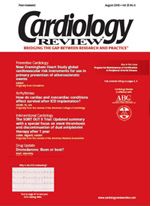Publication
Article
Cardiology Review® Online
Identifying unrecognized diabetes in the elderly
The incidence of diabetes in the elderly is increasing rapidly, and as Pasmantier points out in her review (page 12), the number of patients requiring treatment increases if seniors are challenged by oral glucose tolerance testing. Because type 2 diabetes is a syndrome that includes elevated blood glucose, dyslipidemia, and hypertension, the patients identified to be at risk would benefit from aggressive treatment of all the components of the diabetic syndrome.
Is it worth the effort of glucose tolerance testing to identify unrecognized patients with diabetes? The data from several clinical trials reviewed by Pasmantier are convincing. In the Rancho Bernardo study, subjects underwent 75-g oral glucose tolerance testing and blood glucose was measured after 2 hours. Results showed at least 50% of the subjects were diabetic patients who would not have been diagnosed if fasting plasma glucose alone was measured.1
How can we identify patients at risk for diabetes who would benefit from glucose tolerance testing? Patients with fasting blood glucose of 100 to 125 mg/dL, dyslipidemia, especially high triglycerides, low high-density lipoprotein cholesterol, central obesity, body mass indexes greater than 30 kg/m2, hypertension, and a family history of diabetes would be candidates for the glucose challenge.
Because there are special issues regarding management in the elderly diabetic patient, a referral to a certified diabetes educator can alleviate many potential risks. Detailed education regarding foot care, insulin delivery skills, glucose monitoring, individualized meal planning, and timing of medication with food are all areas that need close scrutiny.
Weight management, which is essential in all patients with diabetes, is especially important in the elderly. The Diabetes Prevention Program provides important information for our elderly prediabetic and diabetic patients.2 No medication can achieve better blood glucose lowering and cardiovascular disease prevention than diet and exercise. Exercising five times a week for 30 minutes and losing 7% of body weight by careful dietary management achieves a 58% reduction in the incidence of diabetes in patients with impaired glucose tolerance.
Attention should also be focused on the increased risk of hypoglycemia in elderly diabetic patients. An emphasis on tight blood glucose control can leave elderly patients particularly vulnerable to hypoglycemia because of several factors, such as decreases in counterregulatory hormones at night, decreases in appetite resulting in intake of fewer calories, and changes in activity level.
It will take a concerted effort by insurance companies, the American Diabetes Association, and the American Heart Association to encourage physicians to identify patients with diabetes as early as possible. It will take a team effort between primary care physicians, cardiologists, endocrinologists, and diabetes educators to manage the complex strategies and multiple medications needed for controlling blood glucose, blood pressure, lipid levels, smoking, and weight in elderly patients who are at risk for or diagnosed with diabetes.





